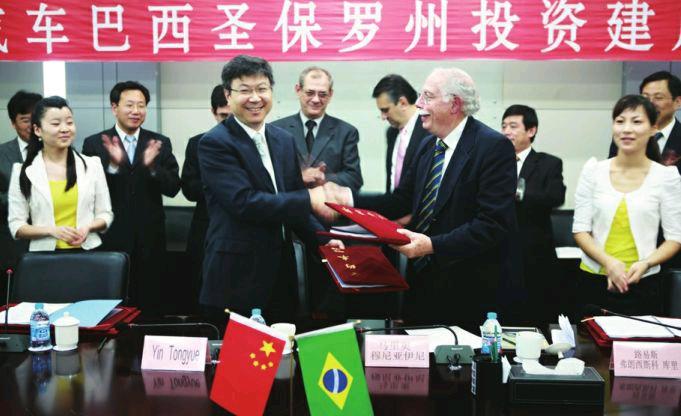Chinese Carmakers Race for Latin American Market
2014-09-27BystaffreporterDA
By+staff+reporter+DANG+XIAOFEI
AFTER recovering from the shock of the world financial crisis, Chinas automobile exports to Latin America are begining to climb. Chinese auto manufacturers, represented by Chery Automobile and Great Wall Motors, are accelerating their efforts to conquer the Latin American market.
Opportunities in Latin America
After a swift rebound over recent years, Latin America is now the third largest destination for Chinese automobiles, after the Middle East and Africa.
“Latin America has been a major area of growth since 2013, and the market will grow even faster in 2014 due to high demand. Moreover, Chinese carmakers have gradually strengthened their footholds there,” said the export business manager of Zhejiang Gonow Automobile Co., Ltd. “Chile and Brazil are priority markets, followed by Columbia, Uruguay and Ecuador, while Venezuela is a separate market.”
Strong economic growth in Latin American countries has created high potential for the regions automobile market. Because China and Latin America are evenly matched in automotive technical requirements, the market threshold is not high.
Currently Peru and Chile offer the highest sales volumes to Chinese carmakers. According to Julio Concha, sales manager of Derco Company in Peru, Chinese carmakers have a price advantage which has helped them to successfully penetrate Peru and Chile and make inroads into Bolivia, Uruguay, Paraguay, and Columbia.
“Forty Chinese automobile brands have found stable long-term sales in Peru, and another 10 to 15 brands have recently entered the market. Dump trucks sell the best here because there is a huge demand among young entrepreneurs and small businesses. They need quality automobiles at reasonable prices,” said Mr. Concha.
Zhu Yi, an engineer at the China Automotive Technology and Research Center, identifies two advantages for Chinese automobiles in Chile. First, he says, as a consequence of the Free Trade Agreement between Chile and China, au-tomobile exports are tariff-free. Second, Chinese-made automobiles are available in many types and sizes, mostly falling into the lower price range. These relative advantages have allowed Chinese manufacturers to steadily expand their market share in Chile.
Growing Sales of Commercial Vehicles
Chinese commercial vehicles have remarkably advanced in technology, added value and brand recognition. These improvements have given them a growing niche in the Latin American market. Statistics show that in the first quarter of 2013 Latin America accounted for 20.62 percent of Chinas automobile exports, up from 14.71 percent in 2008. Chile, Peru and Venezuela are the largest buyers of Chinese commercial vehicles.
Many leading Chinese brands, such as China National Heavy Duty Truck Group Co., Ltd., Beiben Trucks Group Co., Ltd., Zhengzhou Yutong Group Co., Ltd., King Long Motor Group, Higer Bus Company Limited and Zonda Group, have entered the Latin American market.
Actually Latin America is among the first foreign markets for Chinese commercial vehicles. Although geographically removed from China, many countries in the region are at a parellel level of social and economic development, and therefore have similar demands for automobiles.
In the 1980s China began to export commercial vehicles to Latin America, which was then dominated by Japanese brands. Chinese manufacturers earned their places based on reasonable prices and high quality.
China-made passenger cars and commercial vehicles entered the Chile market at an early time and in large quantities. Trucks are a “latecomer,” but have also achieved praiseworthy performance. According to statistics from the Automobile Industry Committee of China Council for the Promotion of International Trade (CCPIT), in 2007 only two percent of the total imported commercial vehicles in Chile came from China. The share grew to 19 percent in 2011. China then became the No.2 truck exporter to Chile, second only to Brazil.
According to Yang Aiguo, deputy secretary general of the Automobile Branch of the China Chamber of Commerce for Import & Export of Machinery & Electronic Products (CCCME), the Chinese government has signed free trade agreements with Chile, Peru and Costa Rica which give Chinese products better access to Latin American market. Furthermore, Latin American countries enjoy zero or low tariffs when doing business with each other, and most have close trade ties with developed European countries and the U.S. Chile, Peru and Costa Rica could serve as a springboard for Chinese manufacturers to resell their products to other countries.
Opportunity and Challenge Coexist
It cannot be overlooked, however, that the Latin American market is complicated and poses both opportunities and challenges.
“People often talk about the openness of the Brazilian market; but they ignore the fact it is “easy to enter but hard to stay” – Brazil imposes relatively high standards on the automobile industry, as regards gasoline and engines,” said a GONOW source.
Trade barriers in Latin America have also had a huge impact on Chinese automobile companies. In 2012, Brazil announced a 30 percent tax hike on carmakers that do not source at least 65 percent of their parts from Brazil and MERCOSUR (the Common Market of the South) countries. Most Chinese auto manufacturers that export to Brazil were affected by the new policy. In the first year after the tax, Cherys sales to Brazil sank from 12,378 vehicles to 4,747, and its market share in the country shrank from 0.46 percent to 0.18 percent.
The fluctuating exchange rates, high cost of sea transportation and the increasingly complicated international trade environment all affect the competitiveness of Chinese automobile enterprises in the overseas market.
Wang Shunsheng, assistant to general manager of GAC Group and chief of GACs International Business Department, said that his company is about to explore the Chilean market; however, the 10 percent decline of the Chilean peso, coupled with the appreciation of the RMB, makes it more difficult for China to export to Chile. GAC now con-siders forward settlement and sale of foreign exchange among other measures to reduce risks brought about by exchange rate changes.
From the viewpoint of Zhang Zhiyong, an analyst in the automobile industry, one of the many reasons for the decline of Chinese automobile exports is that many Chinese automakers try to replicate their domestic operation model in new markets. Cui Dongshu, secretary general of China Passenger Car Association, also holds that the fact that even big Chinese automobile brands, such as Chery and Great Wall, are vulnerable to negative factors in the export market, shows that Chinas automobile industry is still weak in dealing with overseas crises.
Moreover, the fevered race for the international market has resulted in disordered and homogeneous competition among peers. As Shi Jianhua, deputy secretary general of China Association of Automobile Manufactures, sees it: “Chinas finished motor vehicles are mainly exported to Asia, Africa, Latin America and the emerging markets like Brazil and Russia. Overlapped target markets and clients inevitably result in homogeneous competition.”
Chinese carmakers such as Chery and Great Wall are actively seeking to reverse the decline in market shares. As the first Chinese automobile enterprise to establish a factory in Latin America, after setting up its Uruguayan plant Chery invested another US $400 million in 2010 in a factory in Sao Paulo, Brazil, aiming to increase the proportion of locally-produced parts for its cars. Chery also plans to introduce more new models to the Brazilian market, including Tiggo and Arrizo 7.
Some Chinese automobile enterprises, while expanding exports of finished vehicles, are also investing in new factories in Latin America. They include Foton and JAC Motors. Shaanxi Automobile Group Co., Ltd. also announced in June of 2013 its intention to invest US$200 million to set up a factory in Brazil, with an annual capacity of 10,000 heavy-duty trucks. Expected to start operation in mid–2014, this factory will purchase engines, transmission systems and other accessories locally to ensure at least 65 percent of the parts are sourced in Brazil.
Chery has also gradually shifted its focus from export to local production, having invested in new factories in Uruguay and Egypt.
Though newcomers to the international market, Chinas automakers are quickly adapting to new conditions. The future of the Chinese car industry will depend on its ability to survive the pressures of the world economy.
